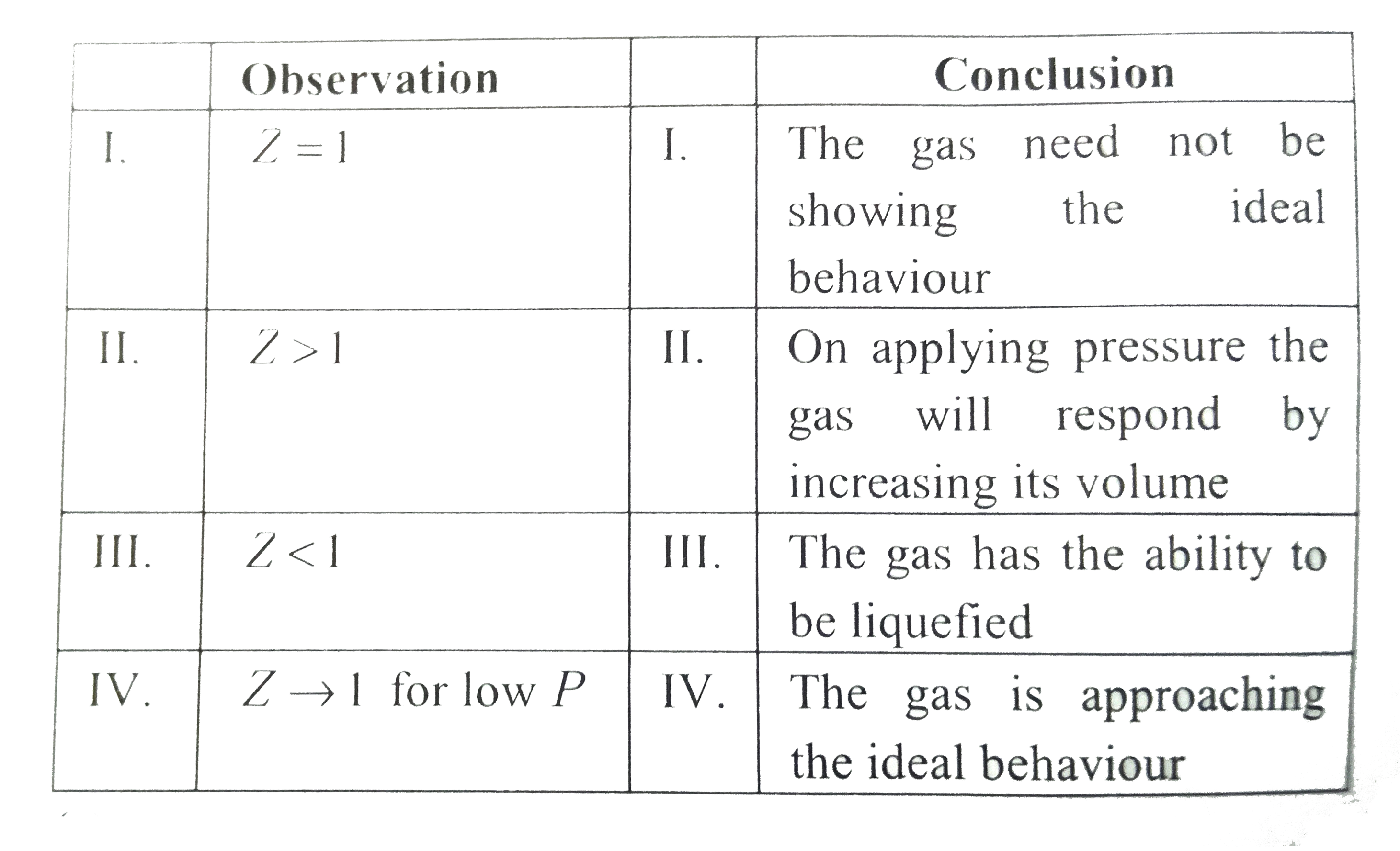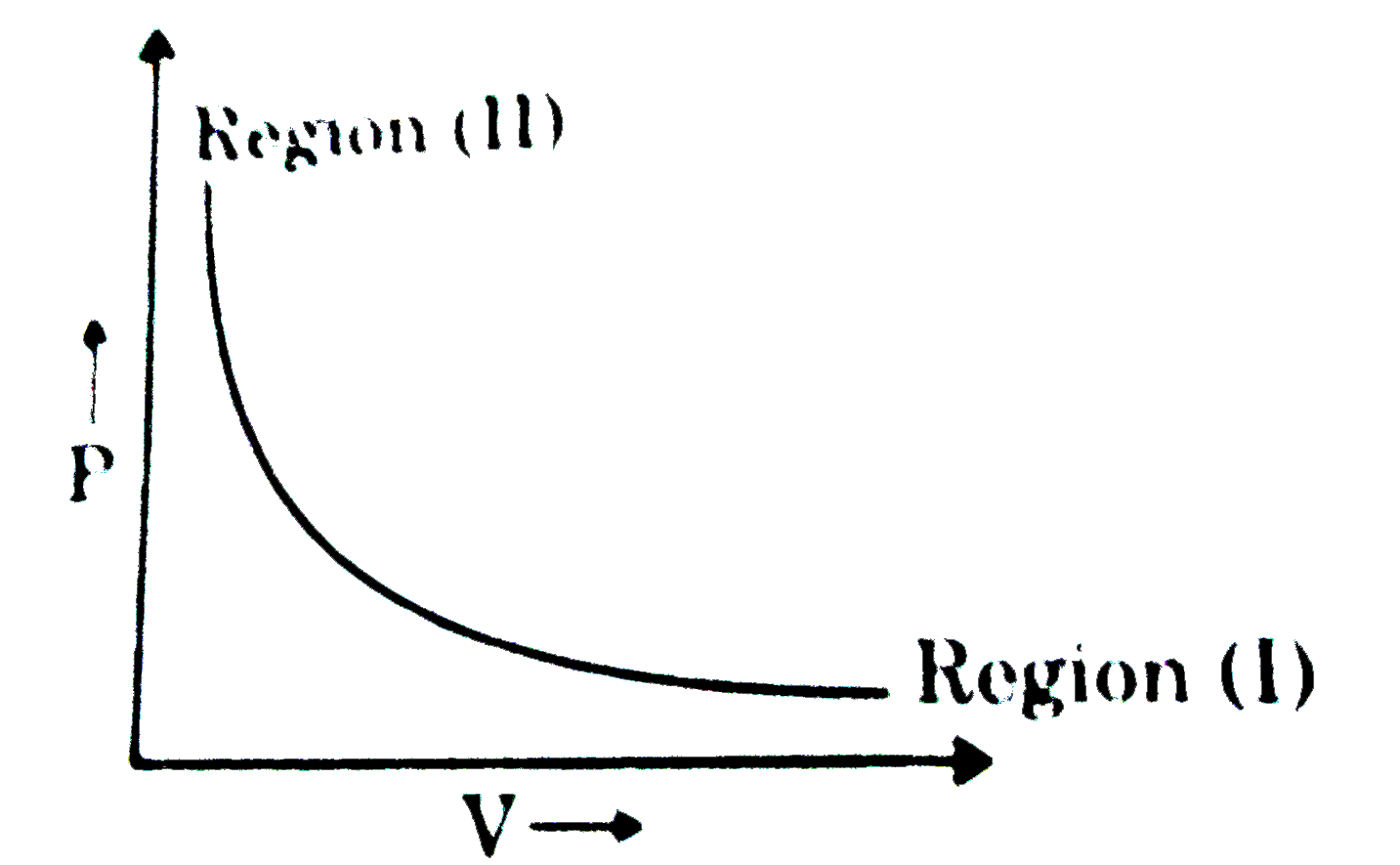One of the approach to the study of real gases involves the analysis of a parameter Z called the compressibility factor Z=PVmRT where P is pressure, Vm is molar volume, T is absolute temperature and R is the universal gas constant . Such a relation can also be expressed as Z=(Vm realVm ideal) (where Vm ideal and Vm real are the molar volume for ideal and real gas respectively) . Gas corresponding Z>1 have repluive tendenciesamong constituent particles due to their size factor, among constitutent particles . As the pressure is lowered or temperature is increased the value of Z approaches 1. ( reaching the ideal behaviour)
Choose the conclusions whcih are appropriate for the observation stated

All conclusions are true
Conclusions I,II and IV are true
Conclusions I,III and IV are true
Conclusions III and IV are true
The correct Answer is:D
(I) Z=1→ Ideal behaviour
(II) Z>→ On applying pressure, volume decreases
(III) Z<1→ Gas can be easily liqueifed .
(IV) At low, P,Z→1 means gas is approaching to ideal behaviour.
Topper's Solved these Questions
- GASEOUS STATE BOOK - ERRORLESS CHAPTER - GASEOUS STATE EXERCISE - JEE SECTION (Integer type questions)
7 Videos
- GASEOUS STATE BOOK - ERRORLESS CHAPTER - GASEOUS STATE EXERCISE - JEE SECTION (Matrix Match type questions)
3 Videos
- GASEOUS STATE BOOK - ERRORLESS CHAPTER - GASEOUS STATE EXERCISE - JEE SECTION Comprehension type question (Passage-I)
2 Videos
- ENVIRONMENTAL CHEMISTRYBOOK - ERRORLESS CHAPTER - ENVIRONMENTAL CHEMISTRYEXERCISE - CRITICAL THINKING (Objective question )
16 Videos
- GENERAL ORGANIC CHEMISTRYBOOK - ERRORLESS CHAPTER - GENERAL ORGANIC CHEMISTRYEXERCISE - Matrix Match type questions
4 Videos
Similar Questions
One of the important approach to the study of real gases involves the analysis of parameter Z called the compressibility factor Z=PVmRT where P is pressure, Vm is molar volume, T is absolute temperature and R is the universal gas constant. such a relation can also be expressed as Z=(VmrealVmal) (where Vmal and Vmreal are the molar volume for ideal and real gas respectively). Gas corresponding Z<1 have attractive forces amoung constituent particles. As the pressure is lowered or temperature is increased the value of Z approaches 1. (reaching the ideal behaviour)
For a real gas GZ>1 at STP Then for 'G': Which of the following is true:
View SolutionOne of the important approach to the study of real gases involves the analysis of parameter Z called the compressibility factor Z=PVmRT where P is pressure, Vm is molar volume, T is absolute temperature and R is the universal gas constant. such a relation can also be expressed as Z=(VmrealVmal) (where Vmal and Vmreal are the molar volume for ideal and real gas respectively). Gas corresponding Z<1 have attractive forces amoung constituent particles. As the pressure is lowered or temperature is increased the value of Z approaches 1. (reaching the ideal behaviour)
ObservationConclusionI.Z=1I.The gas need not be showing the ideal behaviourII.Z>1II.On applying pressure the gas will respond byincreasing its volumeIII.Z<1III.The gas may be liquefiedIV.Z→1for lowPIV.The gas is approaching the ideal behaviour
View Solution
Knowledge Check
One of the approach to the study of real gases involves the analysis of a parameter Z called the compressibility factor Z=PVmRT where P is pressure, Vm is molar volume, T is absolute temperature and R is the universal gas constant . Such a relation can also be expressed as Z=(Vm realVm ideal) (where Vm ideal and Vm real are the molar volume for ideal and real gas respectively) . Gas corresponding Z>1 have repluive tendenciesamong constituent particles due to their size factor, among constitutent particles . As the pressure is lowered or temperature is increased the value of Z approaches 1. ( reaching the ideal behaviour)
For a real gas 'G'Z>1 at STP then for 'G' which of the following is trueA1 mole of the gas occupies 22.4 L at NTPB1 mole of the gas occupies 22.4 L at pressure higher than that at STP (keeping temperature constant)C1 mole of the gas occupies 22.4 L at pressure lower than that at STP ( keeping temperature constant)DNone of the aboveOne of the important approach to the study of real gases involves the analysis of parameter Z called the compressibility factor Z=PVmRT where P is pressure, Vm is molar volume, T is absolute temperature and R is the universal gas constant. such a relation can also be expressed as Z=(VmrealVmal) (where Vmal and Vmreal are the molar volume for ideal and real gas respectively). Gas corresponding Z<1 have attractive forces amoung constituent particles. As the pressure is lowered or temperature is increased the value of Z approaches 1. (reaching the ideal behaviour)
For a real gas GZ>1 at STP Then for 'G': Which of the following is true:A1 mole of the gas occupies 22.4 L at NTPB1 mole of the gas occupies 22.4 L at pressure higher than that at STP (keeping temperature constant)C1 mole of the gas occupies 22.4 L at pressure lower than that at STP (keeping temperature constant)DNone of the aboveOne of the important approach to the study of real gases involves the analysis of parameter Z called the compressibility factor Z=PVmRT where P is pressure, Vm is molar volume, T is absolute temperature and R is the universal gas constant. such a relation can also be expressed as Z=(VmrealVmal) (where Vmal and Vmreal are the molar volume for ideal and real gas respectively). Gas corresponding Z<1 have attractive forces amoung constituent particles. As the pressure is lowered or temperature is increased the value of Z approaches 1. (reaching the ideal behaviour)
Following graph represents a pressure (P) volume (V) relationship at a fixed temperature (T) for n moles of a real gas. The graph has two regions marked (I) and (II). Which of the following options is true.
 AZ<1 in the region (II)BZ=1 I the region (II)CZ=1 for the curveDZ approaches 1 as we move from region (II) to region (I)
AZ<1 in the region (II)BZ=1 I the region (II)CZ=1 for the curveDZ approaches 1 as we move from region (II) to region (I)
One of the important approach to the study of real gases involves the analysis of parameter Z called the compressibility factor Z=PVmRT where P is pressure, Vm is molar volume, T is absolute temperature and R is the universal gas constant. such a relation can also be expressed as Z=(VmrealVmal) (where Vmal and Vmreal are the molar volume for ideal and real gas respectively). Gas corresponding Z<1 have attractive forces amoung constituent particles. As the pressure is lowered or temperature is increased the value of Z approaches 1. (reaching the ideal behaviour)
ObservationConclusionI.Z=1I.The gas need not be showing the ideal behaviourII.Z>1II.On applying pressure the gas will respond byincreasing its volumeIII.Z<1III.The gas may be liquefiedIV.Z→1for lowPIV.The gas is approaching the ideal behaviour
View SolutionOne of the important approach of the study of real gases involves the analysis of a parameter Z called the compressibility factor Z=PVmRT where P is pressure, Vm is molar volume ,T is absolute temperature and R is the universal gas constant .Such a relation can also be expressed as Z=(V m realVm ideal) (where Vm ideal and V_("m real")arethemo≤rvolumeforalandrealgasrespectivelytendenciesamongconstituentpartic≤s.Aspressureisforceamongisloweredortemperatureis∈creasedthevalueofZapproachesalbehaviour<br>Forarealgas'G',Zgt1 at STP, then for 'G' which of the following is true ?
View SolutionOne of the important approach of the study of real gases involves the analysis of a parameter Z called the compressibility factor Z=PVmRT where P is pressure, Vm is molar volume ,T is absolute temperature and R is the universal gas constant .Such a relation can also be expressed as Z=(V m realVm ideal) (where Vm ideal and V_("m real") are the moler volume for ideal and real gas respectively tendencies among constituent particles.As pressure is force among is lowered or temperature is increased the value of Z approaches ideal behaviour
Choose the conslusions which are appropriate for the observation stated
View SolutionOne of the important approach of the study of real gases involves the analysis of a parameter Z called the compressibility factor Z=PVmRT where P is pressure, Vm is molar volume ,T is absolute temperature and R is the universal gas constant .Such a relation can also be expressed as Z=(V m realVm ideal) (where Vm ideal and V_("m real") are the moler volume for ideal and real gas respectively tendencies among constituent particles.As pressure is force among is lowered or temperature is increased the value of Z approaches ideal behaviour
Following graph represents a pressure (P) volume (V) relationship at a fixed temperature (T) for moles of a real gas.The graph has two regions masked (I) and (II). Which of the folloing option true ?

View SolutionThe equation of state of some gases can be expressed as (P+aV2)(V−b)=RT, where P is the pressure, V is the volume, T is the absolute temperature and a, b & R are constants. The dimensions of 'a' are : -
View Solution
